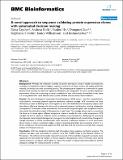| dc.contributor.author | Taycher, Elena | |
| dc.contributor.author | Rolfs, Andreas | |
| dc.contributor.author | Hu, Yanhui | |
| dc.contributor.author | Zuo, Dongmei | |
| dc.contributor.author | Mohr, Stephanie | |
| dc.contributor.author | Williamson, Janice | |
| dc.contributor.author | LaBaer, Joshua | |
| dc.date.accessioned | 2011-03-08T17:46:34Z | |
| dc.date.issued | 2007 | |
| dc.identifier.citation | Taycher, Elena, Andreas Rolfs, Yanhui Hu, Dongmei Zuo, Stephanie E. Mohr, Janice Williamson, and Joshua LaBaer. 2007. A novel approach to sequence validating protein expression clones with automated decision making. BMC Bioinformatics 8: 198. | en_US |
| dc.identifier.issn | 1471-2105 | en_US |
| dc.identifier.uri | http://nrs.harvard.edu/urn-3:HUL.InstRepos:4739147 | |
| dc.description.abstract | Background: Whereas the molecular assembly of protein expression clones is readily automated and routinely accomplished in high throughput, sequence verification of these clones is still largely performed manually, an arduous and time consuming process. The ultimate goal of validation is to determine if a given plasmid clone matches its reference sequence sufficiently to be "acceptable" for use in protein expression experiments. Given the accelerating increase in availability of tens of thousands of unverified clones, there is a strong demand for rapid, efficient and accurate software that automates clone validation. Results: We have developed an Automated Clone Evaluation (ACE) system – the first comprehensive, multi-platform, web-based plasmid sequence verification software package. ACE automates the clone verification process by defining each clone sequence as a list of multidimensional discrepancy objects, each describing a difference between the clone and its expected sequence including the resulting polypeptide consequences. To evaluate clones automatically, this list can be compared against user acceptance criteria that specify the allowable number of discrepancies of each type. This strategy allows users to re-evaluate the same set of clones against different acceptance criteria as needed for use in other experiments. ACE manages the entire sequence validation process including contig management, identifying and annotating discrepancies, determining if discrepancies correspond to polymorphisms and clone finishing. Designed to manage thousands of clones simultaneously, ACE maintains a relational database to store information about clones at various completion stages, project processing parameters and acceptance criteria. In a direct comparison, the automated analysis by ACE took less time and was more accurate than a manual analysis of a 93 gene clone set. Conclusion: ACE was designed to facilitate high throughput clone sequence verification projects. The software has been used successfully to evaluate more than 55,000 clones at the Harvard Institute of Proteomics. The software dramatically reduced the amount of time and labor required to evaluate clone sequences and decreased the number of missed sequence discrepancies, which commonly occur during manual evaluation. In addition, ACE helped to reduce the number of sequencing reads needed to achieve adequate coverage for making decisions on clones. | en_US |
| dc.language.iso | en_US | en_US |
| dc.publisher | BioMed Central | en_US |
| dc.relation.isversionof | doi://10.1186/1471-2105-8-198 | en_US |
| dc.relation.hasversion | http://www.ncbi.nlm.nih.gov/pmc/articles/PMC1914086/pdf/ | en_US |
| dash.license | LAA | |
| dc.title | A Novel Approach to Sequence Validating Protein Expression Clones with Automated Decision Making | en_US |
| dc.type | Journal Article | en_US |
| dc.description.version | Version of Record | en_US |
| dc.relation.journal | BMC Bioinformatics | en_US |
| dash.depositing.author | Rolfs, Andreas | |
| dc.date.available | 2011-03-08T17:46:34Z | |
| dash.affiliation.other | HMS^Biological Chemistry and Molecular Pharmacology | en_US |
| dash.affiliation.other | HMS^Genetics | en_US |
| dc.identifier.doi | 10.1186/1471-2105-8-198 | * |
| dash.contributor.affiliated | Rolfs, Andreas | |
| dash.contributor.affiliated | Zuo, Dongmei | |
| dash.contributor.affiliated | Mohr, Stephanie | |
| dash.contributor.affiliated | Hu, Yanhui | |


